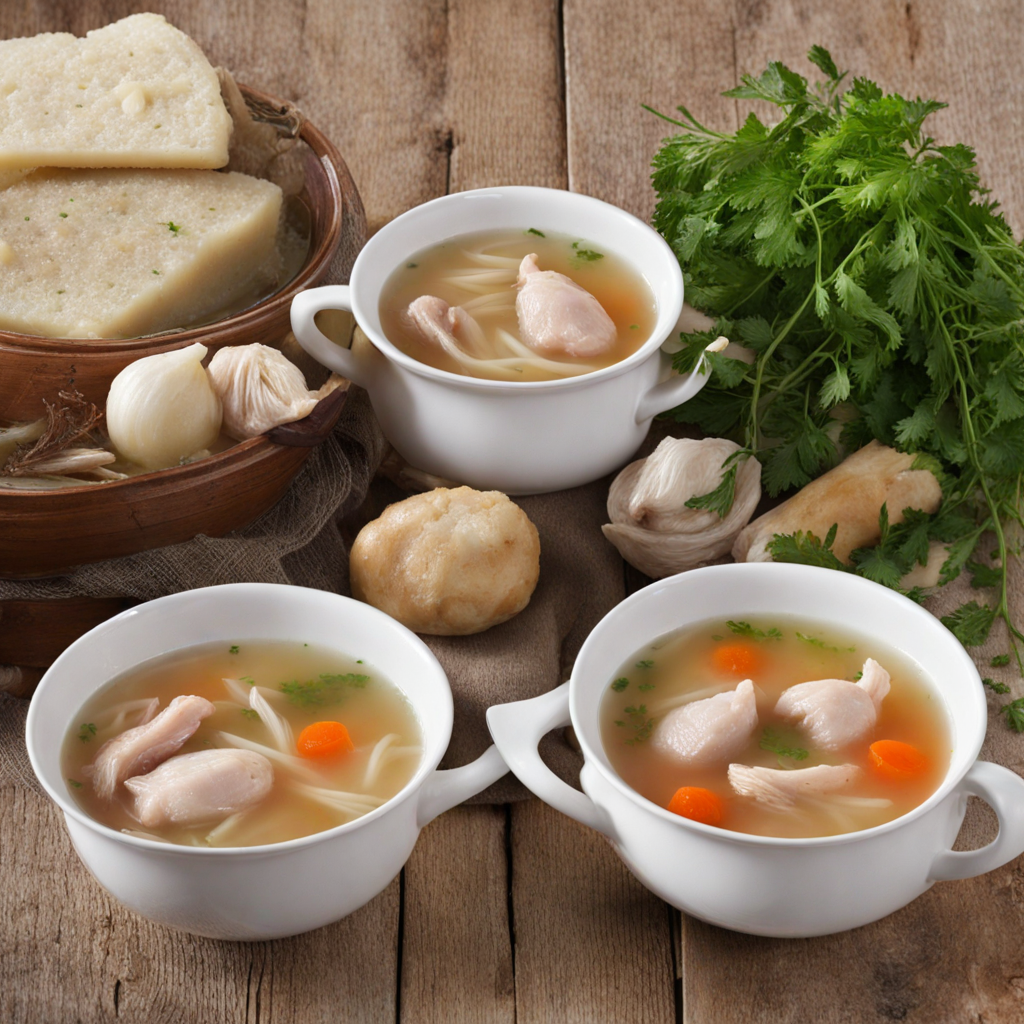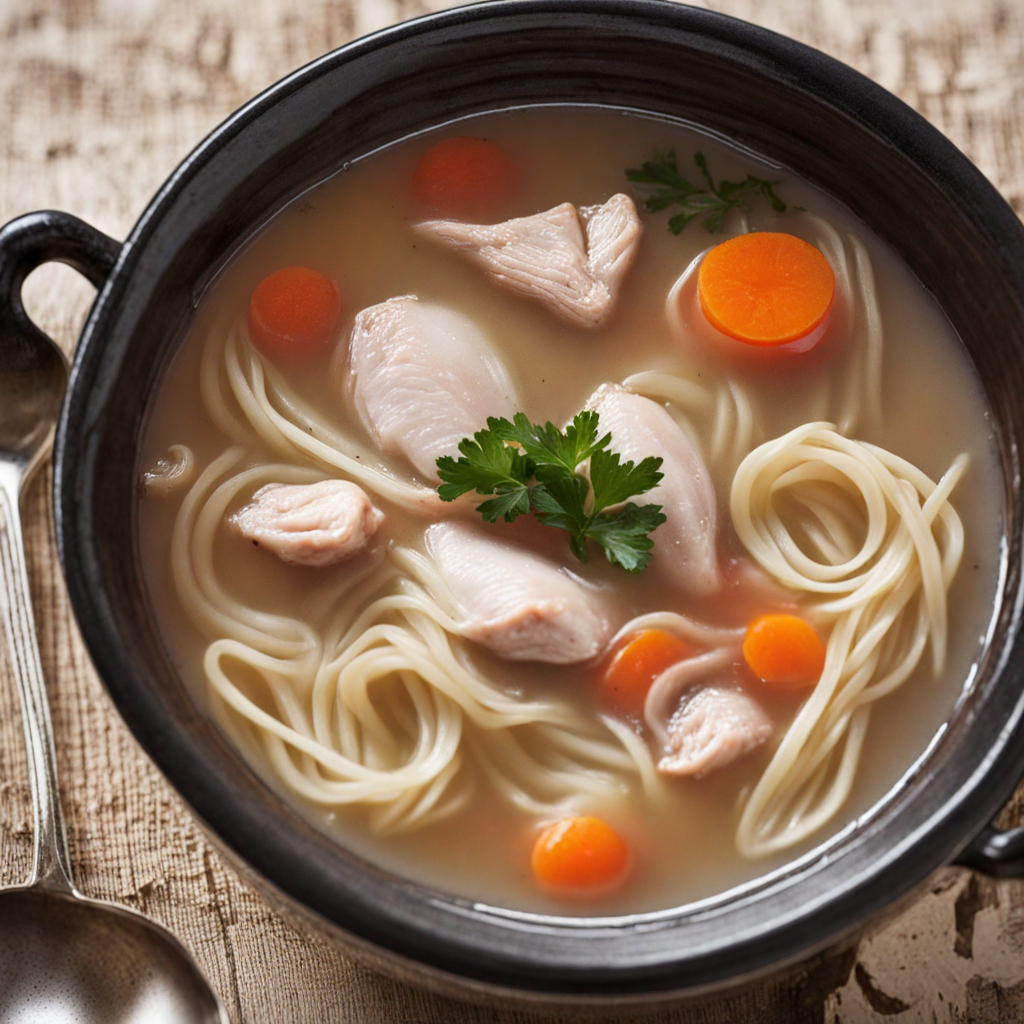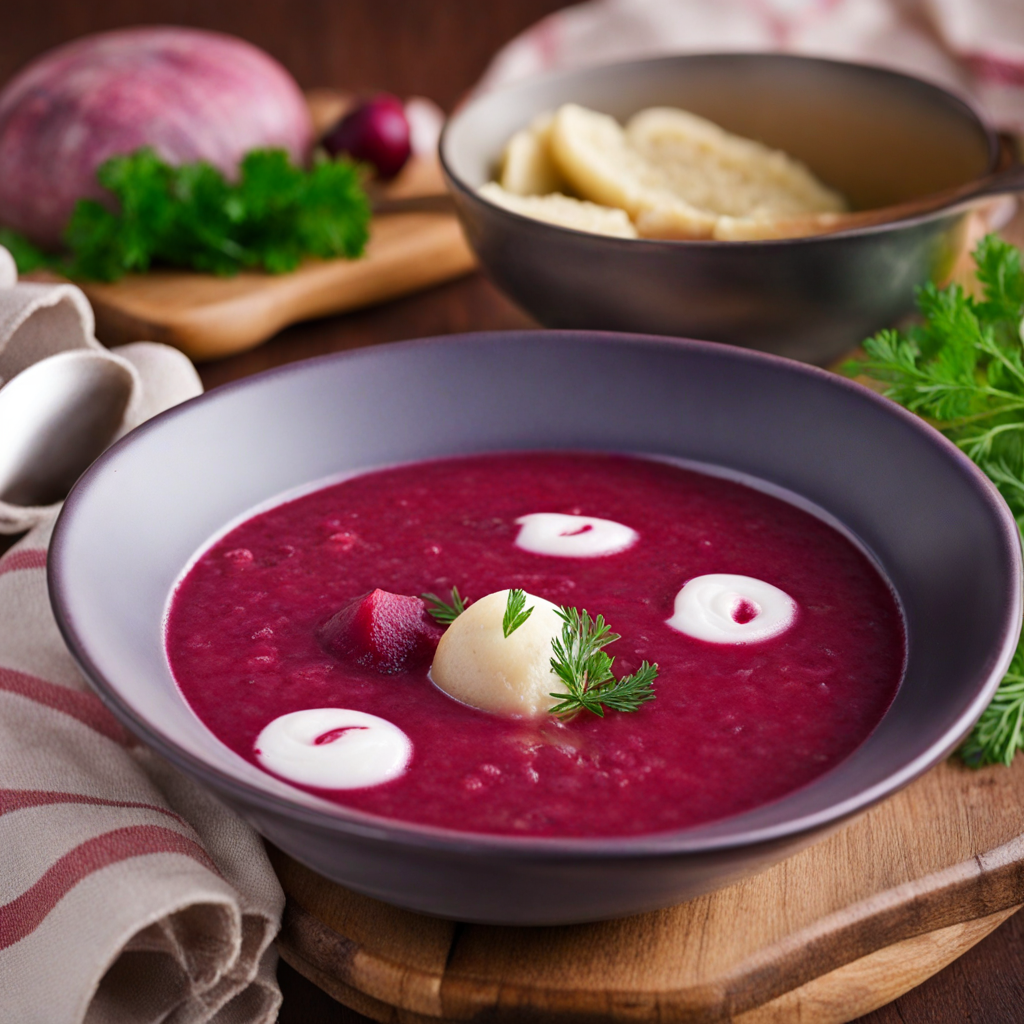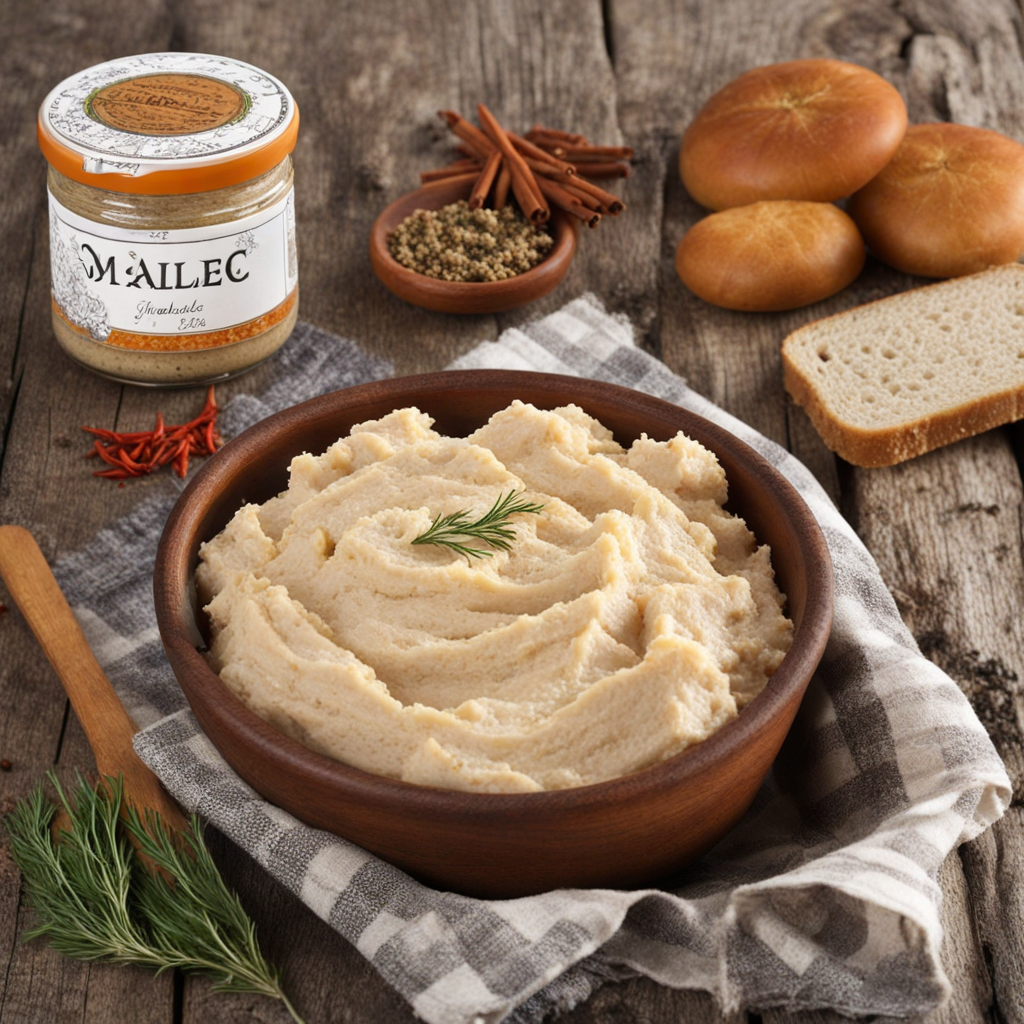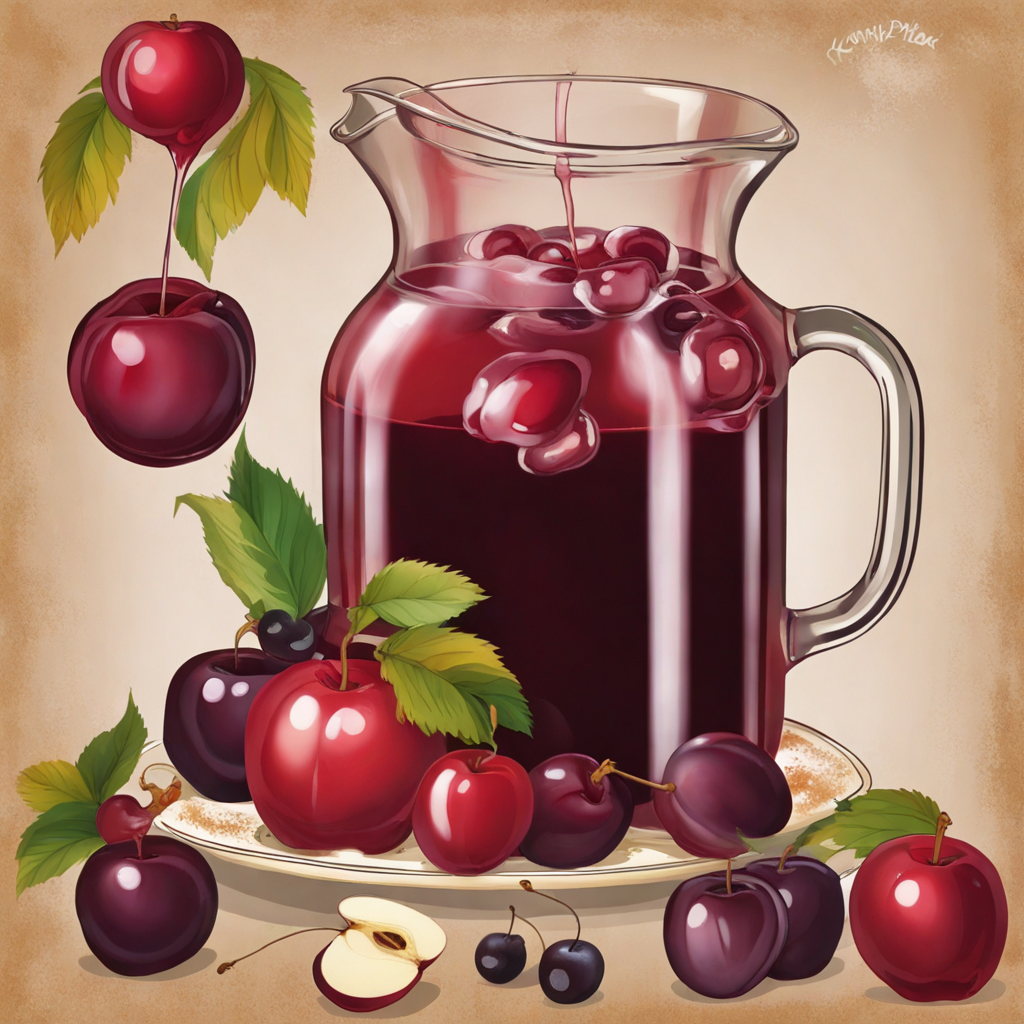Rosół
Rosół is a traditional Polish chicken soup that serves as a culinary emblem of comfort and home. The base is a clear, golden broth, typically made by simmering chicken, often with the addition of beef, along with a medley of aromatic vegetables such as carrots, celery, and onions. This slow cooking process extracts rich flavors, resulting in a deeply satisfying and fragrant soup that warms both body and soul. The broth is often seasoned with herbs like parsley and dill, which add a fresh note to the dish, creating a delightful balance of flavors that is both savory and inviting. What sets Rosół apart is not just its flavor but also its cultural significance. It's commonly served on Sundays or during family gatherings, often accompanied by homemade noodles or dumplings, which add a hearty touch to the meal. The noodles soak up the rich broth, creating a delightful combination of textures. A sprinkle of fresh herbs on top enhances the visual appeal and adds a burst of freshness, making each bowl a comforting and nourishing experience. Rosół is more than just a dish; it is a symbol of Polish hospitality and tradition. It is often enjoyed as a starter, perfect for warming up appetites before the main course. Whether enjoyed on a chilly winter evening or as a special family meal, Rosół embodies the essence of Polish cuisine—simple, wholesome, and full of heart. Each spoonful tells a story of warmth, family, and the joy of sharing a meal, making it a must-try for anyone looking to explore the rich tapestry of flavors in Polish gastronomy.
How It Became This Dish
The History of Rosół: Poland's Beloved Broth Origins of Rosół Rosół, a traditional Polish chicken soup, has its roots deeply embedded in the culinary history of Poland, a country rich in agricultural heritage and diverse cultural influences. The word "rosół" itself comes from the Latin "ros solis," meaning "dew of the sun," which poetically suggests the nourishing qualities of the broth. Its origins can be traced back to medieval times, where it was often prepared as a simple, hearty dish using available ingredients. The earliest records of a dish resembling rosół appear in 17th-century Polish cookbooks, reflecting the growing importance of soup as a staple in Polish cuisine. The fundamental ingredients of rosół—chicken, vegetables, and spices—are not merely practical but also symbolic. The use of chicken, for instance, is significant within Slavic cultures, often associated with family gatherings and celebrations. The dish is typically flavored with carrots, parsley, celery, and sometimes noodles, contributing to its comforting and wholesome character. Cultural Significance Rosół is much more than just a dish; it holds a special place in Polish culture and the hearts of its people. Often regarded as the quintessential comfort food, it is commonly served on Sundays, during family gatherings, or on special occasions. Its preparation is a ritual, often passed down through generations, embodying the warmth of home and the love of family. In Poland, rosół is frequently associated with traditional Sunday dinners, where families gather to enjoy a leisurely meal together. This ritual has been so ingrained in Polish society that it is often referred to as "the Polish Sunday soup." The act of sharing this dish is a reminder of familial bonds and the importance of nurturing relationships, making it a central part of Polish culinary tradition. Moreover, rosół has played a role in Polish cultural identity, symbolizing resilience and comfort through periods of hardship. In times of war and scarcity, the ability to create a nourishing meal from simple ingredients became a source of pride and sustenance. During the communist era, when food was rationed and limited, rosół served as a reminder of home and normalcy, bringing families together around the table despite external challenges. Development Over Time As Poland underwent significant historical changes—from the partitions in the late 18th century to the tumultuous events of the 20th century—the preparation and presentation of rosół evolved. In the 19th century, as the middle class began to emerge, the dish gained sophistication. It was no longer just a rustic broth but became a symbol of culinary refinement in Polish society. It was often served at weddings and important gatherings, showcasing not only a family's culinary skills but also their social standing. Regional variations of rosół also began to develop, reflecting the diverse influences and ingredients found across Poland. In the Mazovia region, for instance, the broth is typically clear and served with homemade noodles, while in Silesia, it might include dumplings or other local specialties. Some variations incorporate beef or veal alongside the chicken, adding depth and richness to the flavor profile. The use of spices and herbs also varied from household to household, with each family adding their unique touch to the recipe. The 20th century brought further changes, particularly after World War II, as Poland opened up to international influences. The globalization of food culture introduced new ingredients and culinary techniques, leading to creative interpretations of traditional recipes. However, the essence of rosół remained intact, continuing to symbolize comfort and homecoming. In contemporary Poland, rosół is celebrated not only as a family dish but also as a cultural icon. It features prominently in Polish restaurants, where chefs often pay homage to traditional recipes while experimenting with modern twists. Cookbooks dedicated to Polish cuisine frequently include rosół, showcasing its significance as a foundational dish. Its presence in popular culture has also been reinforced through media, where it is often portrayed in films and literature as a symbol of nostalgia and comfort. Rosół in Modern Times Today, rosół continues to be a cornerstone of Polish cuisine, loved by both the young and the old. Its preparation often involves a communal effort, with family members coming together to chop vegetables, simmer the broth, and serve the dish, reinforcing the importance of togetherness in Polish culture. The modern twist on rosół can be seen in the growing popularity of vegetarian and vegan versions, which aim to replicate the deep flavors of the traditional broth using plant-based ingredients. In Poland, it is not uncommon for people to keep a "rosół pot" simmering on the stove, allowing the flavors to meld over time. This practice reflects the nurturing aspect of the dish, as it is not just about sustenance but also about the care that goes into its preparation. For many Poles, a bowl of rosół is akin to a warm hug—comforting, familiar, and deeply satisfying. Moreover, rosół has found its place in the diaspora, where Polish communities around the world continue to cherish this dish as a symbol of their heritage. In places like Chicago, London, and Toronto, Polish restaurants serve rosół to remind expatriates of home and to introduce newcomers to the rich flavors of Polish cuisine. Conclusion The journey of rosół from a simple medieval broth to a cherished cultural icon illustrates the power of food as a vessel for memory, identity, and connection. It embodies the essence of Polish hospitality and the warmth of family gatherings, serving as a reminder of the importance of tradition in an ever-changing world. As Poland continues to evolve, so too will rosół, adapting to new influences while remaining a steadfast symbol of comfort and culinary heritage. Whether enjoyed on a cold winter day or during a festive gathering, a bowl of rosół continues to nourish not just the body, but also the soul—a true testament to its enduring legacy in Polish culture.
You may like
Discover local flavors from Poland


